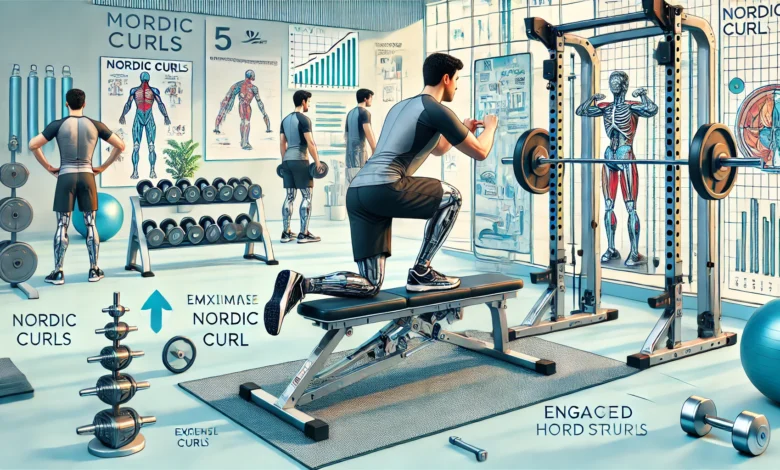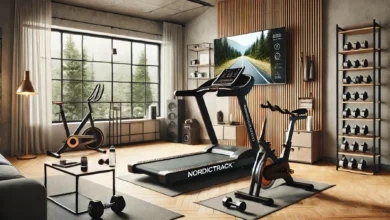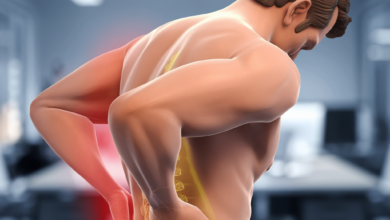How to Perform Nordic Curls for Maximum Results

Introduction
Nordic curls are widely regarded as one of the most effective exercises for strengthening the hamstrings. They target the hamstrings in a way that few other exercises can match, improving not only leg strength but also performance in various athletic activities. If you’re looking to elevate your lower-body training routine, Nordic curls should be at the top of your list.
Despite their proven effectiveness, many people struggle to perform Nordic curls correctly. The exercise demands both strength and control, and improper form can lead to less-than-optimal results or even injury. Furthermore, athletes often neglect this movement, focusing instead on squats and leg presses, missing out on the benefits of eccentric hamstring training.
In this guide, we’ll dive deep into the details of Nordic curls—explaining how to execute them with perfect form, how to modify the exercise for different fitness levels, and how to incorporate them into your training for maximum benefits. Whether you’re a beginner or an experienced athlete, you’ll find actionable advice for improving your Nordic curl technique and achieving stronger hamstrings.
What Are Nordic Curls?
Nordic curls, also known as Nordic hamstring curls, are a bodyweight exercise that targets the hamstrings by emphasizing eccentric muscle contractions. In an eccentric contraction, the muscle lengthens while under tension, which has been shown to increase strength, improve muscle elasticity, and reduce injury risks, particularly in high-intensity sports.
Nordic curls are unique because they focus primarily on the hamstrings’ ability to decelerate movement during the lowering phase (eccentric). This makes them vastly different from exercises like leg curls or deadlifts, which primarily work the muscles during the concentric phase (muscle shortening).
Why are Nordic Curls So Effective?
- Hamstring Activation: Nordic curls offer one of the best ways to isolate and strengthen the hamstrings, which are critical for activities like running, sprinting, and jumping.
- Eccentric Strength: This exercise builds eccentric strength, which has been linked to reduced muscle strains and injuries, particularly in the hamstrings. Eccentric training is critical for athletes who rely on explosive power.
- Functional Strength: The strength gained from Nordic curls transfers well to real-world activities that require running, sprinting, and jumping.
Proper Technique: Step-by-Step Guide
To ensure maximum benefits, it’s essential to execute Nordic curls with proper form. Let’s break down the technique for performing Nordic curls step by step:
Step 1: Preparation
- Equipment Needed: You can perform Nordic curls with minimal equipment. A partner, Nordic curl bench, or resistance band can assist in stabilizing your feet. If you’re at a gym, a leg press machine or a barbell can help anchor your feet as well.
- Body Positioning: Kneel on a padded surface (like a mat or soft flooring) with your knees hip-width apart. Your feet should be securely anchored, either by a partner, equipment, or an immovable object like a heavy bench. Keep your body upright and engage your core to stabilize your spine throughout the exercise.
Step 2: Positioning Your Body
- Torso and Arms: Engage your core to keep your torso straight throughout the movement. You should maintain a neutral spine, avoiding any sagging in the lower back. Keep your arms extended in front of you, either for balance or for extra support as you lower your body.
- Focus on Alignment: Ensure your hips remain extended—don’t allow your pelvis to rotate or sag. Your knees, hips, and shoulders should be aligned in one straight line.
Step 3: Lowering Your Body
- Controlled Descent: Begin by slowly lowering your torso toward the floor by bending at the knees. Resist gravity and use your hamstrings to control the movement. As you descend, keep your body in a straight line. The key is to move slowly—this will maximize the eccentric load on your hamstrings, leading to greater strength gains.
- Focus on the Hamstrings: During this phase, it’s crucial to focus on engaging the hamstrings. If you start to feel your lower back or quads taking over, it might mean your hamstrings aren’t fully engaged. This can lead to a less effective workout.
Step 4: Engaging Muscles During the Eccentric Phase
- Hamstring Focus: The eccentric phase is the heart of Nordic curls. During the descent, ensure you’re actively controlling the movement by contracting your hamstrings. Avoid letting your body drop rapidly—this defeats the purpose of the exercise and reduces its effectiveness.
- Depth of Descent: Aim for a controlled, full range of motion. If you are unable to control the descent all the way to the floor, don’t worry. Start with partial reps and work your way to a full range of motion as your hamstrings gain strength.
Step 5: Reaching the Ground and Returning to Starting Position
- Controlled Fall: Once you can no longer resist the descent, either gently lower your body to the floor or use your hands to catch yourself. If you fall, use your arms to push yourself back to the starting position.
- Return to Starting Position: Use your hamstrings and core to pull your body back up to the kneeling position. Keep the movement controlled—don’t use momentum. If you’re advanced, you may add weight or increase the rep range for added intensity.
Common Mistakes to Avoid:
- Using Momentum: The key to Nordic curls is slow, controlled movement. Relying on momentum undermines the eccentric benefits of the exercise.
- Incorrect Core Engagement: Failing to engage your core can lead to lower back strain. Always maintain a neutral spine.
- Sagging Hips: If your hips drop out of alignment, you reduce the exercise’s effectiveness and place strain on your lower back.
Tips for Maximizing Results
To get the most out of your Nordic curls, follow these additional tips:
- Focus on the Eccentric Phase: Slow down the descent to maximize hamstring activation. Aim for a 3-5 second lowering phase, which increases the time under tension for your hamstrings.
- Incorporate Progressions: Start with assistance (resistance bands or a partner) to perform partial reps. Gradually reduce assistance and aim to perform full Nordic curls unassisted as your strength improves.
- Variation for Intensity: For advanced lifters, add weight (dumbbells or weight plates) to increase resistance during the eccentric phase. Another option is to perform Nordic curls on an unstable surface to challenge your stability further.
- Reps and Sets: Aim for 3-4 sets of 6-8 reps. If you’re a beginner, start with 1-2 sets and gradually increase over time as your hamstrings become stronger.
How to Modify Nordic Curls for Different Fitness Levels
Beginners:
- Assistance: Use a resistance band or a partner to help you during the eccentric phase. This will reduce the load on your hamstrings and allow you to focus on proper technique. You can also try performing partial Nordic curls, where you only lower your body halfway down before returning to the starting position.
- Range of Motion: If you can’t lower your body fully, don’t worry. Begin by practicing partial reps, gradually working towards a full range of motion as your strength increases.
Intermediate:
- Perform full Nordic curls with bodyweight alone. Focus on controlling the eccentric phase and avoid rushing through the movement. Gradually increase the time under tension to increase muscle growth and strength.
Advanced:
- Add extra resistance to make the exercise more challenging. You can hold a weight plate against your chest or add resistance bands for a more intense eccentric contraction. Another option is to increase the number of reps or sets, or even use a Nordic curl bench for a more controlled movement.
Benefits Beyond Hamstrings
While Nordic curls are primarily known for strengthening the hamstrings, they offer additional benefits:
- Core Strength and Stability: Nordic curls engage the core throughout the movement, strengthening your abdominals and improving overall stability. This makes them a great full-body exercise.
- Improved Athletic Performance: Strong hamstrings contribute to better sprinting speed, jumping ability, and agility, making Nordic curls a staple for athletes in sports like soccer, basketball, and track and field.
- Injury Prevention: By focusing on the eccentric phase, Nordic curls enhance muscle elasticity and resilience, significantly lowering the risk of hamstring strains or tears, especially in athletes who perform high-intensity activities.
Common Mistakes and How to Avoid Them
- Using Too Much Momentum: Keep your movements controlled. Don’t allow your body to fall too quickly or push yourself up too forcefully.
- Not Engaging the Core: A strong, engaged core prevents lower back strain. Keep your core tight and maintain proper spinal alignment throughout the exercise.
- Improper Knee and Hip Alignment: Ensure your knees and hips stay in alignment. If your hips drop out of alignment, it may lead to lower back strain.
Conclusion
Nordic curls are a powerful, effective exercise for strengthening the hamstrings, preventing injury, and enhancing athletic performance. By performing them with proper form, focusing on the eccentric phase, and gradually progressing the difficulty, you can maximize the benefits of this exercise. Whether you’re a beginner or advanced, Nordic curls will help you develop stronger, more resilient hamstrings and contribute to overall lower body strength.




